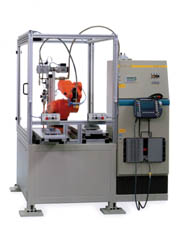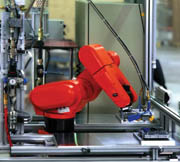
Kern-Liebers USA Dispensing Technology designed the system for the customer, adding a manual-loaded shuttle table and a small UV-curing oven. This kept the cost low and the work cell small. Several of the small cells can be grouped together to produce a variety of parts without the headaches of a larger system.
Because of its modular design and control-integration capability, the DG-MO1 dispensing system simplified the system-design process. Programming the robot to act as the dispensing arm of the DG-MO1 was accomplished quickly and accurately. Streamlining these design considerations reduces the payback time of the system and builds in flexibility to ease any future changes in part design or sealing material. The system was built in Schramberg, Germany, and commissioned in just one day at the customer’s plant in Mexico.

Compact and Fast
The DG-MO1 dispensing system is distinguished by its low-floor-space requirement, high speed and integration-ready PLC control system. The connectors in the fuel-injector control module are sealed with three gaskets to protect against dust and moisture. The gaskets, 3-mm wide and 2-mm thick, are made of single-component silicone and are dispensed in just 10 seconds.For the first time, Kern-Liebers combined the DG-MO1 modular dispensing system with the three-kilogram payload robot, chosen for this highly compact system due to its small dimensions. The robot controller is linked directly to the DG-MO1 PLC system. All dispensing and robotic parameters can be entered directly and monitored continuously using a single teach pendant. A ceramic sealing nozzle makes the system practically wear-free and eliminates the need for cleaning shots during operation.
The double-sliding shuttle table is loaded and unloaded manually. The UV-curing oven is just one-meter long and cures the gaskets in only two minutes.
A number of important factors make this type of dispensing equipment a better investment compared to other types of systems:
· Shorter payback period due to lower initial cost;
· Faster operator training: the learning curve is not as steep;
· Smaller machine footprint, approx. 77 in (2,000 mm) x 53 in (1,350 mm);
· Flexible system to handle part changes;
· Accurate, precise system;
· Single- or two-component dispensing;
Static, dynamic or static-dynamic mixing options.
While robots, PLCs, dispensing systems and UV ovens are not new technologies, it is novel when a manufacturer can successfully combine these systems in a small, reliable cell.
